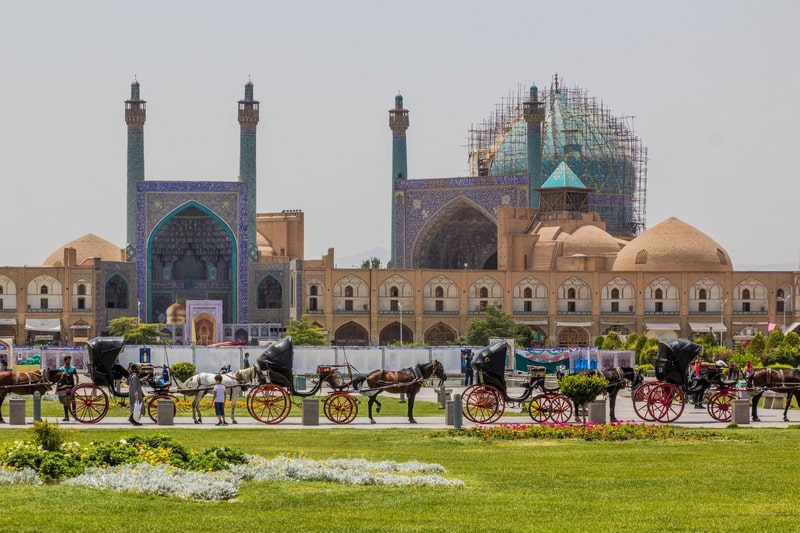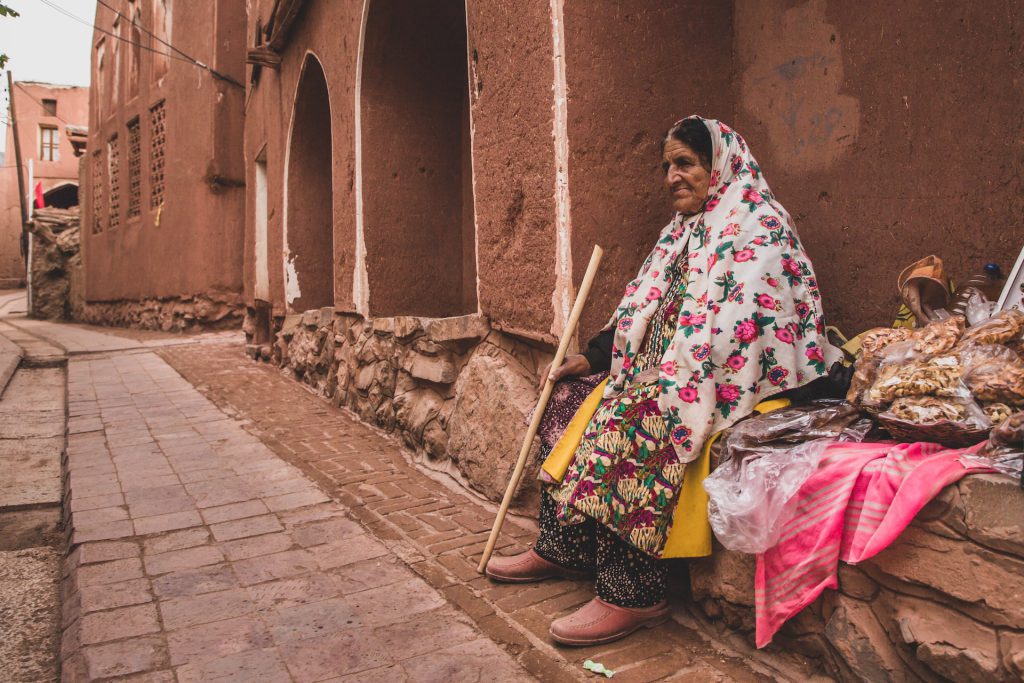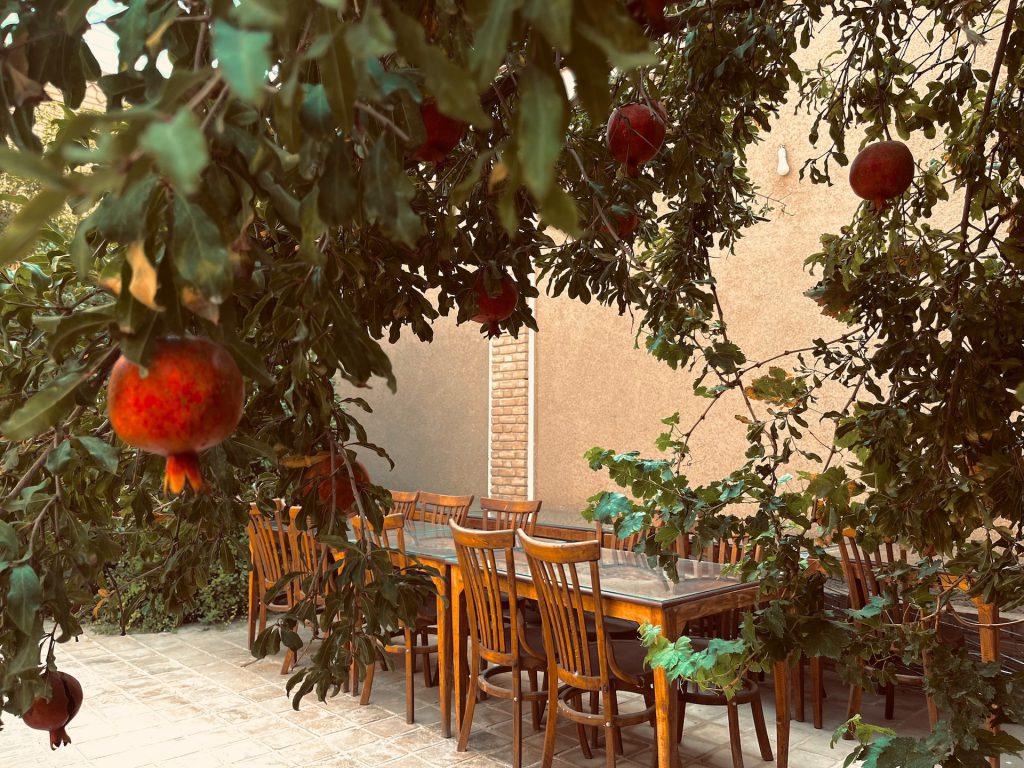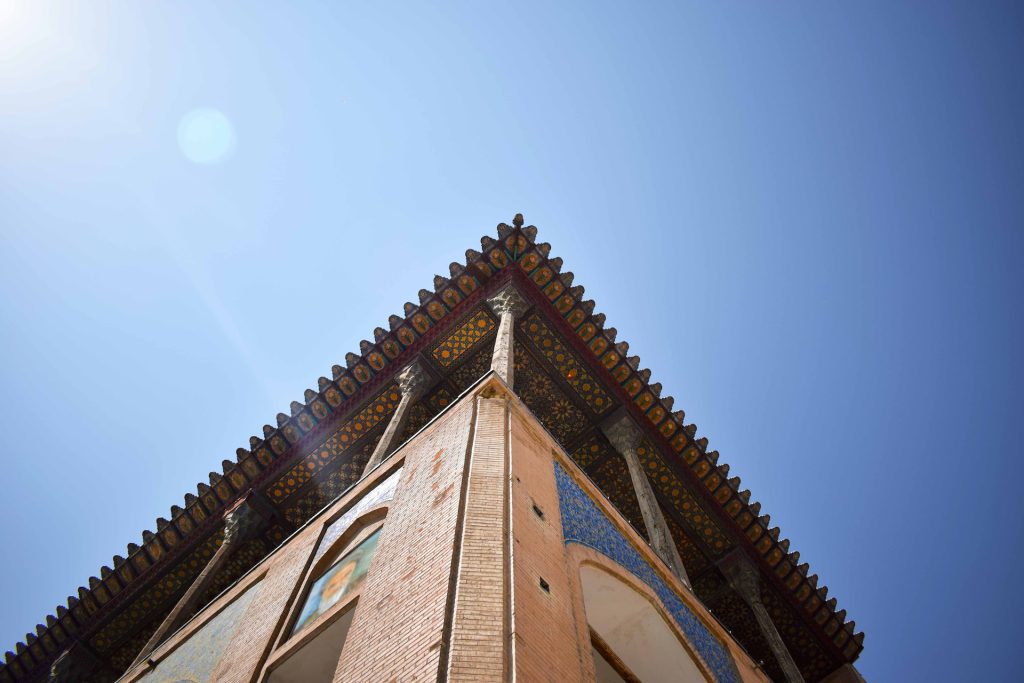Table of Contents
Isfahan in a Glance
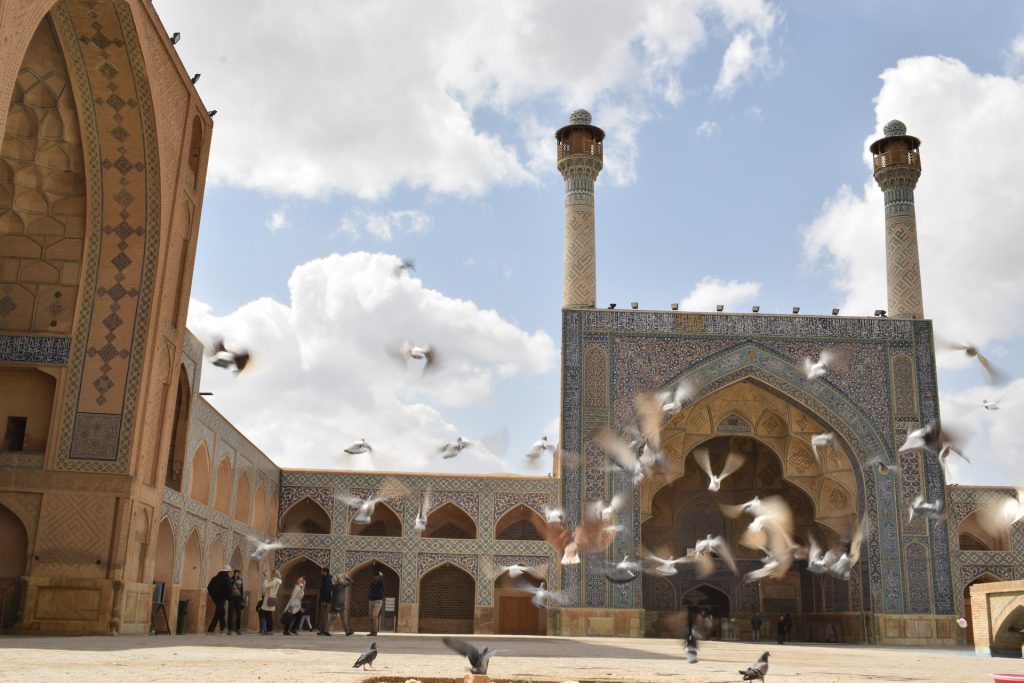
Isfahan is an important city as it is located at the intersection of the two principal north-south and east-west routes that traverse Iran.
From 1050 to 1722, it flourished particularly in the 16th and 17th centuries under the reign of the Safavid dynasty since Isfahan was their capital.
It is famous for its Perso-Islamic architecture, grand boulevards, historic bridges, palaces, tiled mosques, and minarets. The city also has many historical buildings, monuments, and paintings.
This city is known as “Nesf-e-Jahaan” which means half of the world. It is given to this city because of its several wonders and beauties.
History of Isfahan
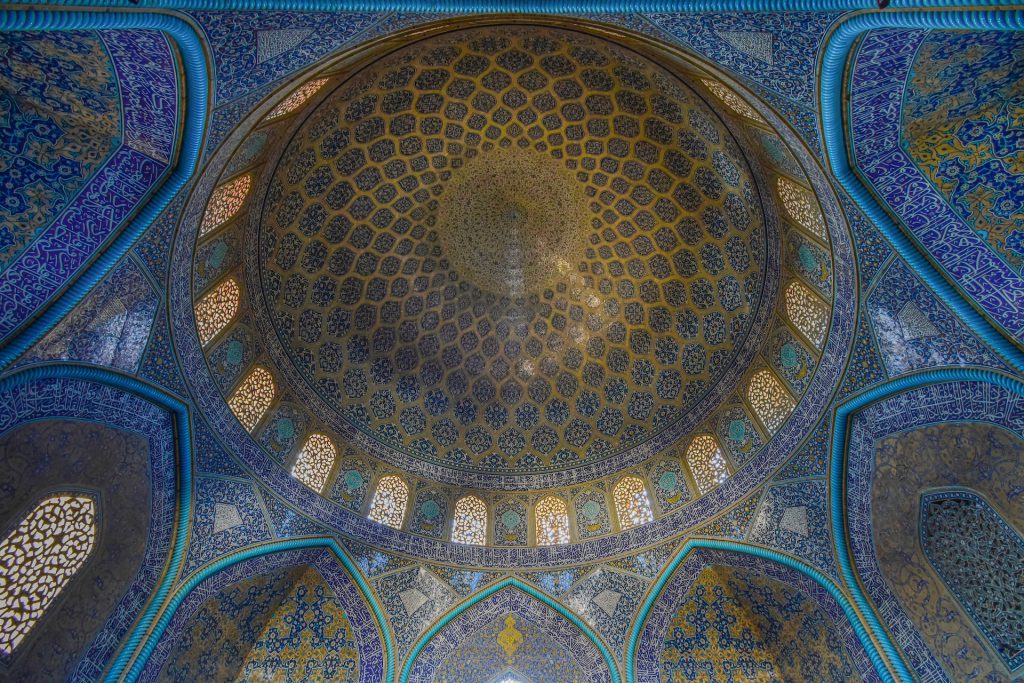
Step into the captivating world of Isfahan, a city steeped in history that weaves together a rich tapestry of ancient splendor. Its origins trace back to the time of the Achaemenid Empire, an era that unfolded over two thousand years ago. During this remarkable period, the city emerged as a vibrant and cosmopolitan center, embracing diversity and fostering an atmosphere of religious and ethnic tolerance. It stood proudly among the great cities of its time, rivaling the grandeur of Athens and Rome, and surpassing even the magnificence of London, Paris, and Istanbul.
The city, once a sprawling metropolis, pulsated with life and left an indelible mark on the pages of history. Its streets echoed with the footsteps of generations, its architecture spoke of bygone glory, and its spirit resonated with the aspirations of countless souls. Nestled in the heart of Persia, the city blossomed into an urban marvel, captivating the imagination of all who beheld its splendor. Its rise to prominence was nothing short of extraordinary, captivating the hearts of conquerors and poets alike. The city’s captivating beauty transcended time and space, leaving an everlasting impression on the story of human civilization.
Isfahan Geological Characteristics
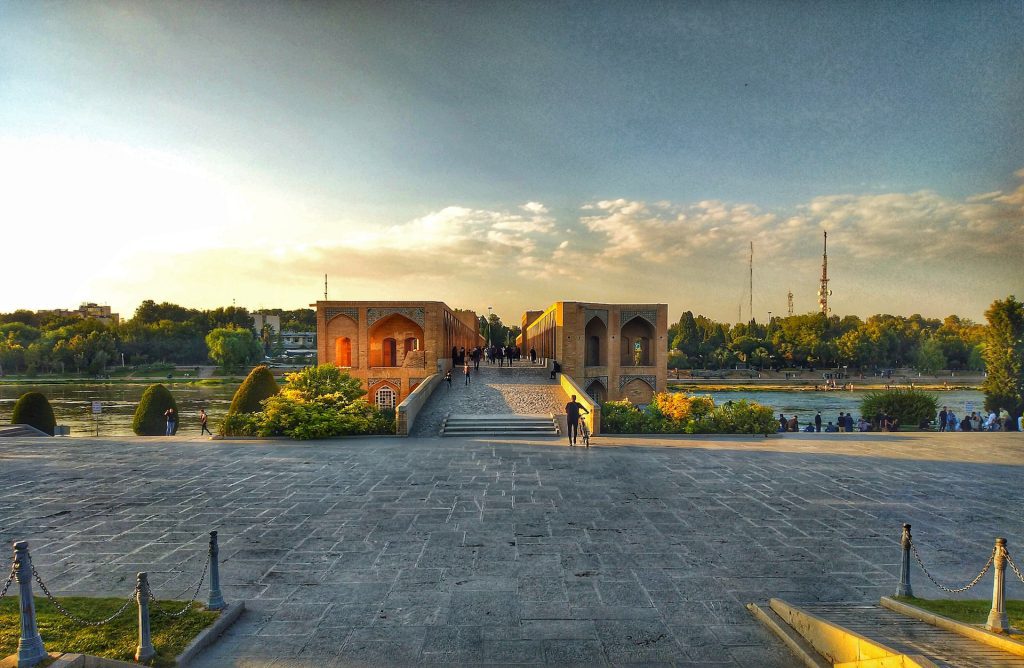
Located in the central region of Iran, Isfahan province boasts a fascinating geographical setting. At its heart lies the Isfahan Metropolitan, situated on the vast ZRT and alluvium plain. This expansive area, consisting mostly of sedimentary deposits like silt and clay, showcases the diversity and richness of the region’s natural landscape.
The geographical wonders of the city are a sight to behold. The ZRT and alluvium plain, with their fertile soil, have played a vital role in supporting agriculture and sustaining the livelihoods of the local communities. The region’s ecosystems thrive amidst this fertile land, creating a diverse and captivating environment.
With its breathtaking scenery and panoramic views, the province offers a visual treat for visitors. Rivers and lakes gracefully wind through the terrain, providing sustenance for plants, animals, and human settlements. The province’s remarkable geography serves as a backdrop for the captivating history and culture of the city, blending the beauty of nature with the achievements of humanity.
Isfahan Weather/Climate
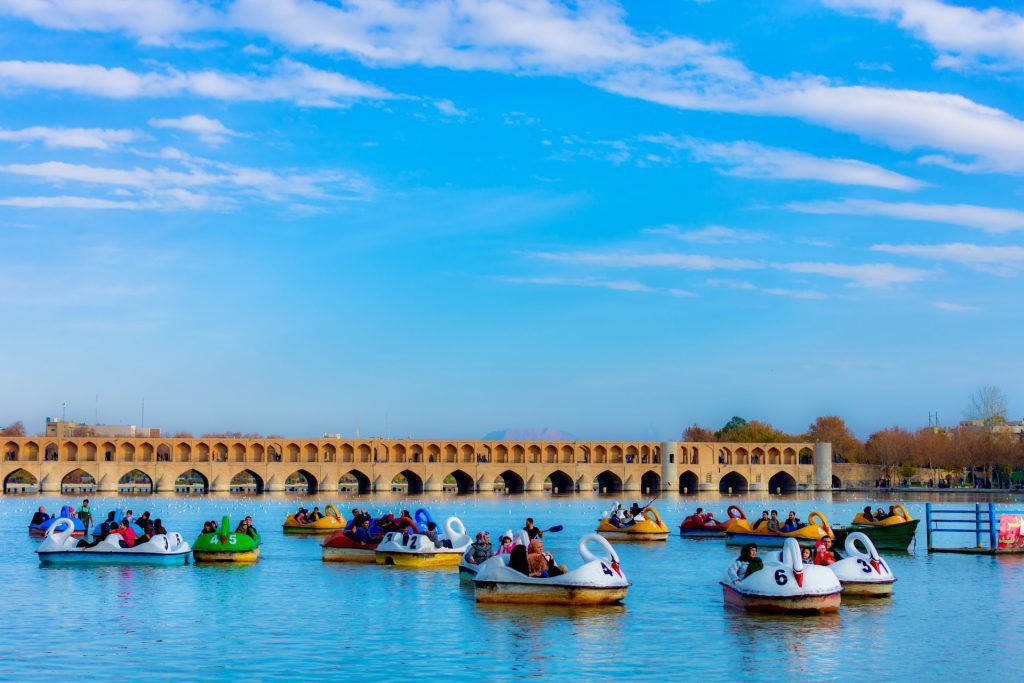
The western and central parts of the province are mountainous with a mild and dry climate. But the east and northeast regions are hot and dry. Because the Dasht-e Kavir, Iran’s largest desert, surrounded these regions. Also, there is a river flowing from the east to the southwest of the province which people call Zayenderood. Actually, Zayenderood means the fertile river. It is obvious from its name that the climate depends on this river.
In fact, Zayenderood has two effects on the climate: the first one is watering the plain. Many canals distribute Zayenderood’s water within the plain and this is why this name is given to the river. The second effect is caused by humidity. Without Zayenderoud, half of the world is so dry.
Top Places to See in Isfahan
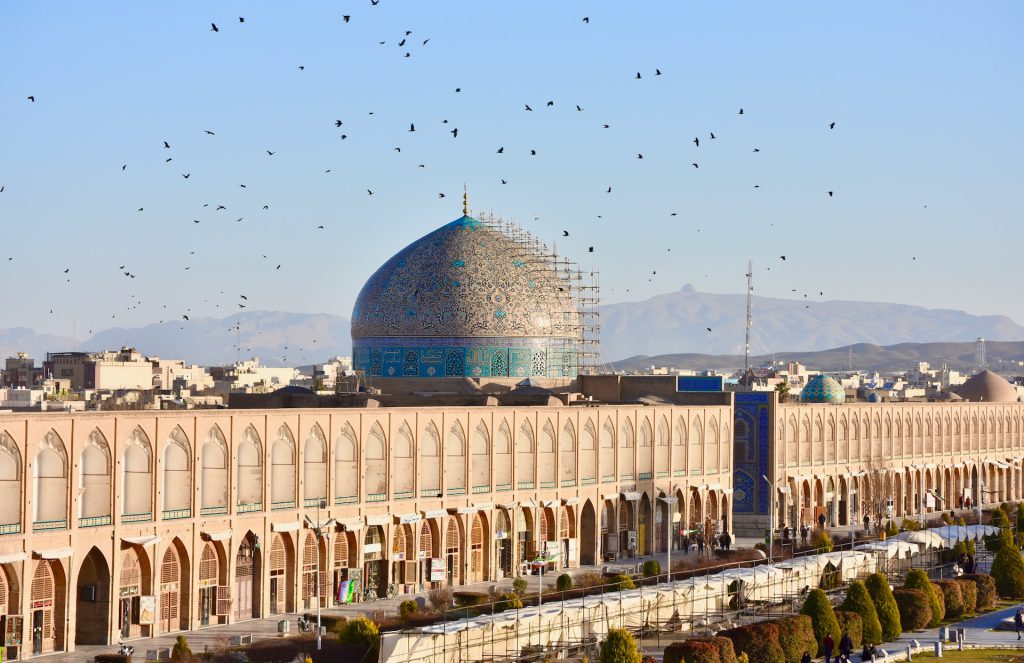
Isfahan city in Iran is known for its old and beautiful buildings. Here are some of the amazing and pretty places you should visit:
Naqshe Jahan Square
Naqsh-e Jahan Square, also called Shah Square and Imam Square, is the most famous place in Isfahan and a UNESCO World Heritage Site. It’s a must-see spot that’s always busy with tourists. The name means “The Image of the World” in Farsi, showing how special it is. The square is surrounded by different buildings and the main bazaar of Isfahan, making it a big area to explore.
Built between 1598 and 1629 by Shah Abbas, the square was made to celebrate Isfahan as the new capital and a place for important events. The square’s design was focused on showing the power of different groups in Iran. It has important buildings like the Shah Mosque, the Imperial Bazaar, and Ali Qapu Palace. This square is huge, with shops on two levels, reflecting the style of the Safavid Era. During the day, it was a busy place for trading, and at night, it turned into a fun spot with performers and events like Nowruz celebrations and polo matches.
Jame Mosque of Isfahan
Jame Mosque in Isfahan is a very old and important mosque in Iran. It was first built a long time ago on the remains of an old temple. It has special areas where you can see the sky. It’s a big mosque with four of these areas, and the biggest one shows the direction of Mecca.
Different rulers made changes to the mosque over the years, making it bigger and more beautiful. Now, it is a special place that shows the history and culture of Iran.
Khaju Bridge
The Khaju Bridge in Isfahan, Iran, is a special bridge that shows how smart the Persian people were when they built it. It was made in 1650 by Shah Abbas II, an important king from the Safavid time. This bridge is not just for crossing the river, but also a fun place where people meet and history is all around.
The bridge is beautiful, with colorful tiles and paintings everywhere. It’s like walking through a picture book, with each part telling a story. In the middle of the bridge is a special place where Shah Abbas used to sit and look at the view. His chair is gone now, but the stone seat is still there, reminding us of him. When you walk across the Khaju Bridge, you feel like you are traveling back in time, seeing all the amazing history of Persia that is part of the bridge.
Si-o-se-pol Bridge
Si-o-se-pol is the biggest bridge over the river there. It was built a long time ago and connects two parts of the city. It’s also a dam and has 33 parts. Si-o-Se-Pol is a famous bridge in Isfahan, Iran. It crosses the Zayandehrud River. This bridge is very special because it is big, in the center of the city, and has a beautiful design. People love to visit it at night because it is a fun place to be.
The bridge was built between 1599 and 1602 when Shah Abbas was the king. The king’s helper, Allahverdi Khan Undiladze, made sure the bridge was built well. That’s why it has another name, Allahverdi Khan Bridge.
In 1598, Shah Abbas moved the capital city to Isfahan. One reason was that the city was close to the Zayandehrud River. The river helped the city grow and stay healthy. During the time of the Safavid kings, 5 out of 11 bridges were built to cross the river. Over the 400 years, sometimes the river dried up. But Si-o-Se-Pol was still used for other things. People would walk on it in the evenings, have meetings, have events, watch boat races, and do other water sports.
Chehel Sotoun Palace
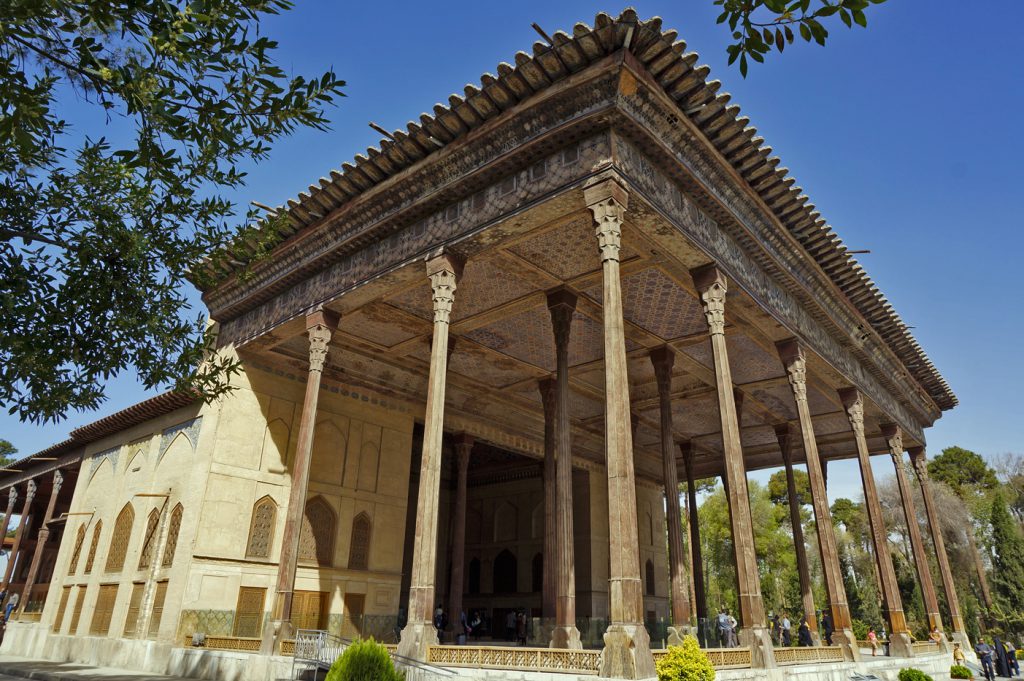
Chehel Sotoun Palace is a treasure in the heart of Isfahan, Iran. This palace dates back to the 17th century and the Safavid dynasty, a time of great wealth and cultural richness. As you walk through its halls, you are taken back to a time when royal ceremonies, important meetings, and artistic events took place.
The name “Chehel Sotoun,” meaning “Forty Columns,” tells a story. The twenty wooden columns seem to double in number when reflected in the pool’s water, creating a magical sight. Every part of Chehel Sotoun Palace holds secrets of the past, where luxury and elegance came together to create a special place for royalty and important guests. Get ready to travel through time as we uncover the rich history of Chehel Sotoun, a journey that will fascinate and inspire.
Menar Jonban
The Menar Jonban is a remarkable architectural site in Iran that dates back around 700 years. What makes this building so special are its two brick minarets that can be set into vibration with just a little bit of pressure. When one minaret starts shaking, the movement spreads throughout the entire structure.
The Menar Jonban was originally built as a mausoleum for a famous mystic named Amo Abdullah, during the patriarchal era. Later on, the Safavid architects added the two shaking minarets to make the building stand out from others in the area. The unique vibration of the minarets is likely caused by a physical phenomenon called resonance, where the similar design of the two towers allows them to shake in sync. Though researchers have studied this effect, the exact reason for the minarets’ captivating movement remains a mystery.
Vank Cathedral
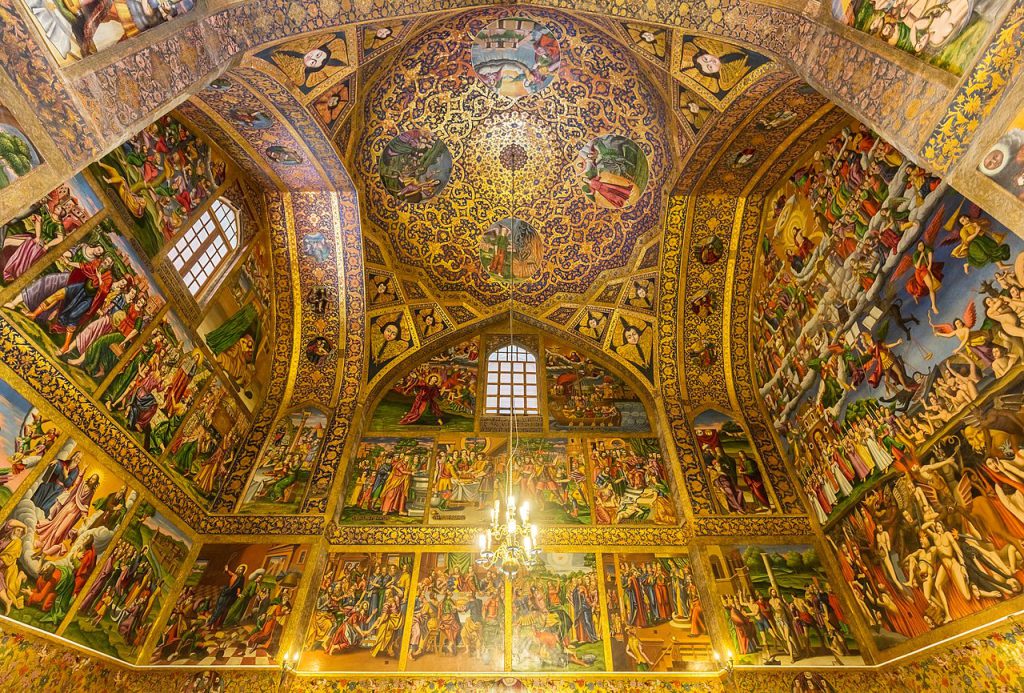
The Vank Cathedral is a famous church located in the city of Isfahan, Iran. It is also known as the Holy Savior Cathedral or the Church of Saintly Sisters. This cathedral is an important Armenian church in the city.
The name “Vank” comes from the Armenian word for “monastery”. This shows that the cathedral has deep roots in Armenian culture and religion. The Vank Cathedral was built during the rule of Shah Abbas, who moved the capital of the Persian Empire to Isfahan in 1598.
The Vank Cathedral blends Armenian and Persian architectural styles, creating a truly unique and captivating building.
Isfahan Music Museum
The Isfahan Music Museum is a must-visit attraction in Iran. Located in the Armenian Quarter of Isfahan, this museum is a treasure trove of musical history and culture. The museum was created by renowned musicians Mehrdad Jeihooni and Shahriar Shokrani, who have assembled a collection of over 300 traditional musical instruments from Iran and around the world.
The museum is divided into seven unique areas, each offering a fascinating glimpse into the world of Persian music. Whether you’re a seasoned musician or simply curious about musical heritage, the Isfahan Music Museum is a truly captivating cultural experience.
Hasht Behesht Palace
The Hasht Behesht Palace is located in the Shahid Rajayi Park in Isfahan, Iran. The park is named after Mohammad-Ali Rajayi, who was the second president of Iran. He was sadly assassinated in a terrorist attack soon after the Iranian revolution. Nowadays, the Shahid Rajayi Park is a lively and vibrant place. People come to the park to relax, have picnics, and let their children play. Retired men sit and chat about their memories of the past.
The Hasht Behesht Palace is an incredible example of the grand and beautiful architecture of Isfahan’s past. Visitors today can explore the palace and admire the skilled craftsmanship that has survived for centuries.
Atashgah (Zoroastrian Fire Temple)
The Atashgah is an old temple located about 8 kilometers west of the city of Isfahan, Iran. It was built during the Sassanian Empire, which ruled ancient Persia for many centuries. The Atashgah was used as a temple by the Zoroastrian religion, which was very important in ancient Persia. It was one of the largest and most important Zoroastrian fire temples at that time. Zoroastrian priests and worshippers would come to the Atashgah to pray.
Though the exact date of when the Atashgah was first built is unclear, we know it was an important religious site during the Sassanian Empire era. It is considered the third largest remaining fire temple from ancient Iran.
These are just a few of the many beautiful places that you should visit.
Shopping and the Best Souvenirs to Buy: Isfahan Travel Guide
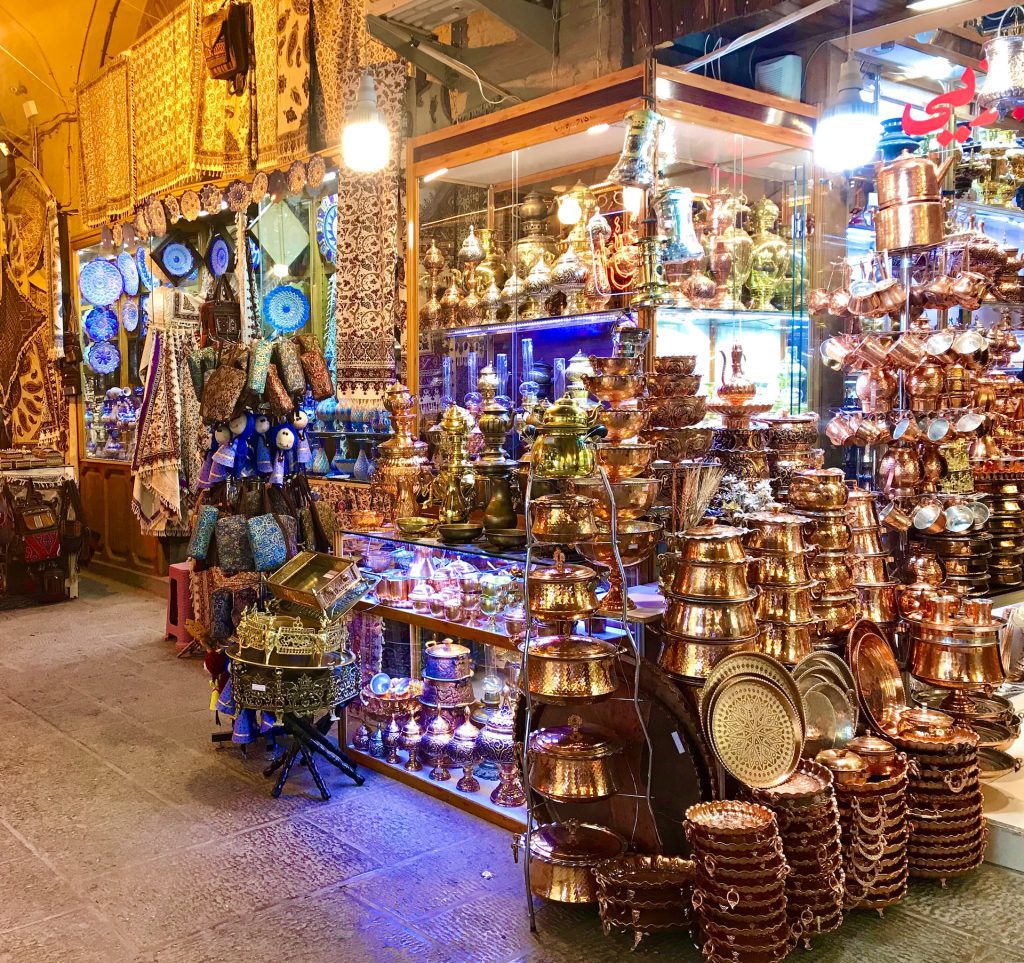
Purchasing souvenirs is often a thrilling aspect of any journey. Isfahan souvenirs have gained worldwide popularity due to their beautiful craftsmanship.
Gaz
One popular edible souvenir is Gaz. It has a long history and was even offered as a gift between kings. Gaz is a sweet confection made with pistachios, rosewater, and other ingredients.
Gaz, the Iranian nougat that originated in the historic city of Isfahan, is a true delicacy with a rich heritage. In the olden days, this exquisite confection was reserved exclusively for the enjoyment of kings and royalty, with ordinary people denied the privilege of savoring its unique flavors. Tracing its roots back over 450 years, Gaz’s origins can be attributed to the pioneering work of Mr. Mohammad Ali Shekarchian, the individual credited with bringing this remarkable treat to life.
Poolaki
Poolaki is a very special candy that comes from the city of Isfahan in Iran. It is a small, thin, and flaky candy that has become one of the most popular souvenirs from Isfahan, second only to the famous Gaz (a nougat-like candy).
Many historians believe that Poolaki was first brought to Iran during the Qajar period, a time when Iranian and Indian cultures had a lot of exchange. The name “Poolaki” in Persian means “small coins”, which is probably because the candy looks a lot like small coins. Poolaki is known to be a very easy and convenient sweet to make at home, so anyone who loves Iranian sweets can try their hand at making it.
Mina-Kari (Vitreous Enamel)
The city is the birthplace of vitreous enamel, an art form that involves decorating metal materials with vibrant colors. It is considered one of the most important handicrafts and is highly appreciated by tourists. It is used to decorate metal containers as well as pottery.
Khatam Kari
Khatam Kari is a traditional woodcraft. Skilled artists create intricate geometric patterns by assembling small pieces and triangles of wooden shapes.
Materials such as bone, gold, silver, brass, and various types of wood are used to create these beautiful designs.
Qalam Kari
Qalam Kari is the art of printing on fabric using wooden molds. Artists create stunning designs on various fabrics, making them visually appealing and unique. It is a simple yet beautiful form of art.
Kashi Kari (Tiling)
Isfahan has a long history of producing tiles. Historic minarets were decorated with Cyan tiles during the Seljuk period.
The city produces a variety of tiles, including building tiles, enameled tiles for exteriors of buildings and mosques, and decorative items like dishes and pots. These tiles often feature intricate designs and vibrant colors.
Nightlife in Isfahan
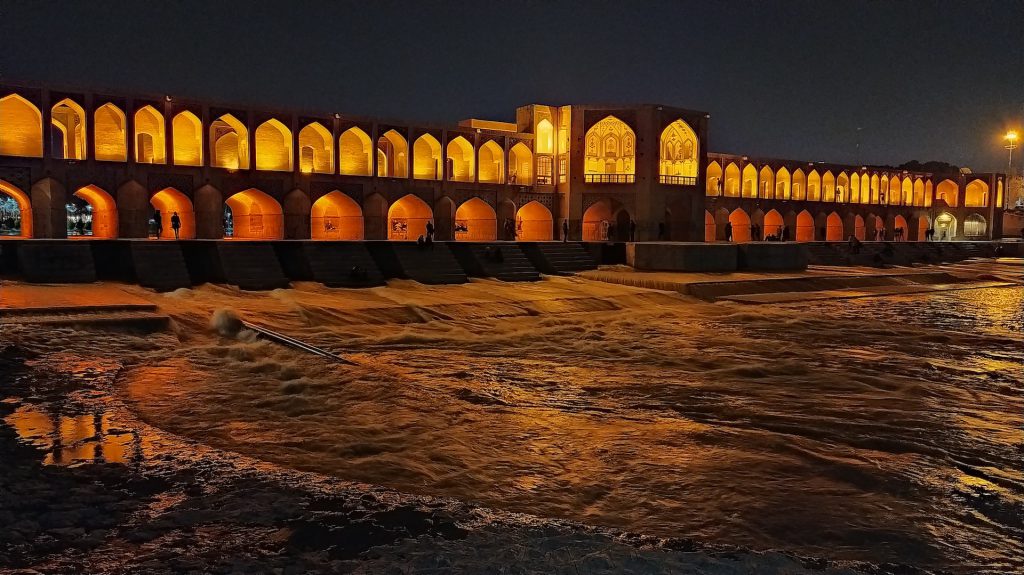
Isfahan city comes alive after dark, offering an exciting nightlife scene. Here are the top places to experience the city’s vibrant evenings:
Si O Se Pol Bridge
Visit this iconic bridge spanning the Zayandeh River. Enjoy the illuminated arches and the lively atmosphere with street vendors selling local treats.
Soffeh Mountain Park
Find peace amidst the city at this serene park. Take a leisurely stroll and admire the stunning night views.
New Julfa
Explore this lively neighborhood known for its Armenian heritage. Discover trendy bars, cozy cafes, and charming restaurants.
Khaju Bridge
Experience the enchantment of traditional music beneath this captivating bridge. Join in the festivities and enjoy the melodies.
Naqsh-E Jahan Square
Conclude your evening at this UNESCO World Heritage site. Admire the illuminated historical buildings and soak in the lively atmosphere.
The nightlife offers a mix of culture, entertainment, and natural beauty. Explore these spots to make the most of your evenings in the city.
Isfahan Suburbs
In addition to the bustling city center, Persia Isfahan offers a variety of charming suburbs and nearby towns that are worth exploring. These suburban areas provide a different perspective on the region, showcasing unique attractions, natural beauty, and cultural experiences.
Abyaneh Village
Set amidst the majestic mountains of Iran, the village of Abyaneh is a hidden gem that captivates all who visit. With its distinctive red-clay buildings and narrow, winding streets, this ancient settlement, as one of the must-see Iran villages, feels like stepping into the past.
What makes Abyaneh so special is the way its people have held onto their traditions over the centuries. As you wander through the village, you’ll see locals wearing traditional costumes and hear them speaking in an ancient Persian dialect. The homes, built in a traditional stepped style, have been carefully maintained, preserving the unique architectural style. It’s as if time has stood still in this enchanting place.
For visitors, a trip to Abyaneh is a chance to experience authentic Iranian culture in a way that is both fascinating and inspiring. By keeping their customs and way of life alive, the people of Abyaneh have created a living, breathing testament to the enduring strength of human culture. Walking through this timeless village is like taking a journey back through the pages of history, a truly unforgettable experience.
Maranjab Desert
The Maranjab Desert is located near the town of Kashan, close to Isfahan. This desert wraps around the town from the north and east. The weather in the Maranjab Desert is very hot and dry during the summers, and cold and dry during the winters. There is very little rain here throughout the year.
Being close to Kashan makes the Maranjab Desert easy to reach. The climate of Kashan also influences the desert’s weather, making the summers scorching, the winters chilly, and rain a rare event. When you step into the Maranjab Desert, you enter a captivating world. This desert is known for its beautiful scenery and the fascinating way its landscape and climate work together in this part of Iran.
How to Get to Isfahan?
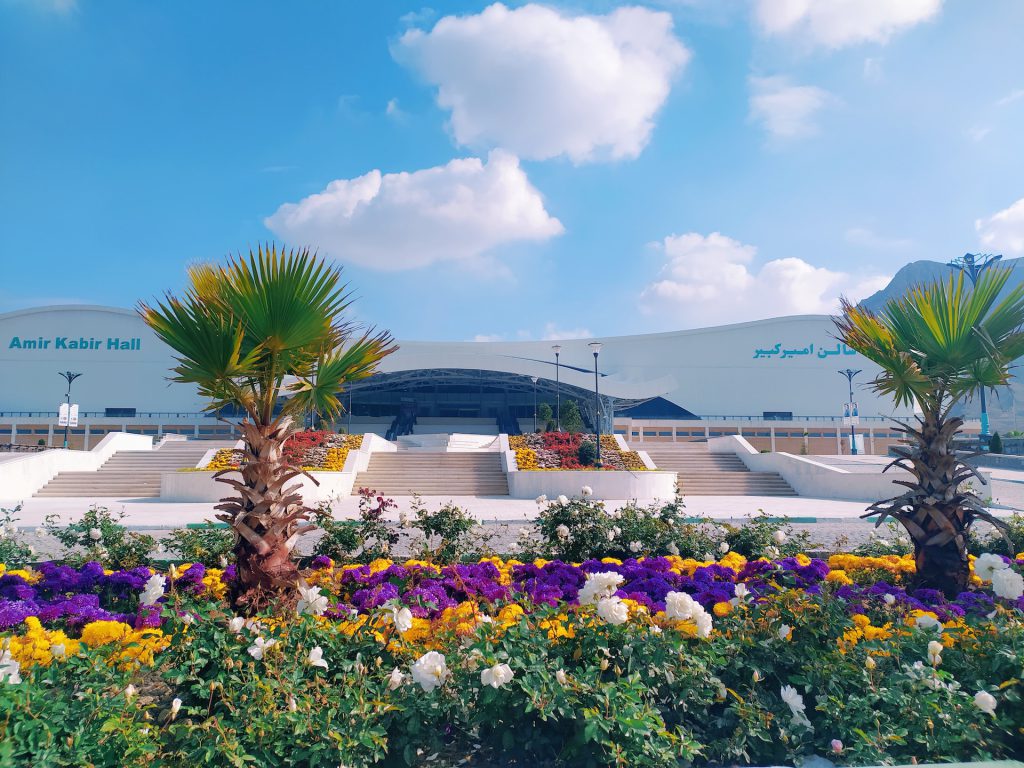
You can reach Isfahan through various modes of transportation:
By Car
You can access the city by car from all directions, including cities like Tehran, Kashan, and Shiraz. The highways connecting these cities are in good condition.
By Bus
The city is well-connected by bus services from major cities, surrounding provinces, and regional towns. Buses from Tehran depart every 30 minutes. VIP buses offer more comfort with spacious seating and amenities like minibars.
By Plane
Daily flights are available from major cities such as Tehran, Mashhad, Tabriz, Shiraz, Ahvaz, and Bandar Abbas. Austrian Airlines also offers direct flights from Vienna to Isfahan, and Turkish Airlines operates daily flights from Istanbul. Check Apochi.com for the latest flight ticket deals.
By Train
There is a daily night train from Tehran to Isfahan, passing through Qom and Kashan along the route. Additionally, a day train operates between Mashhad and Isfahan on a daily basis.
Best Time to Visit in Isfahan
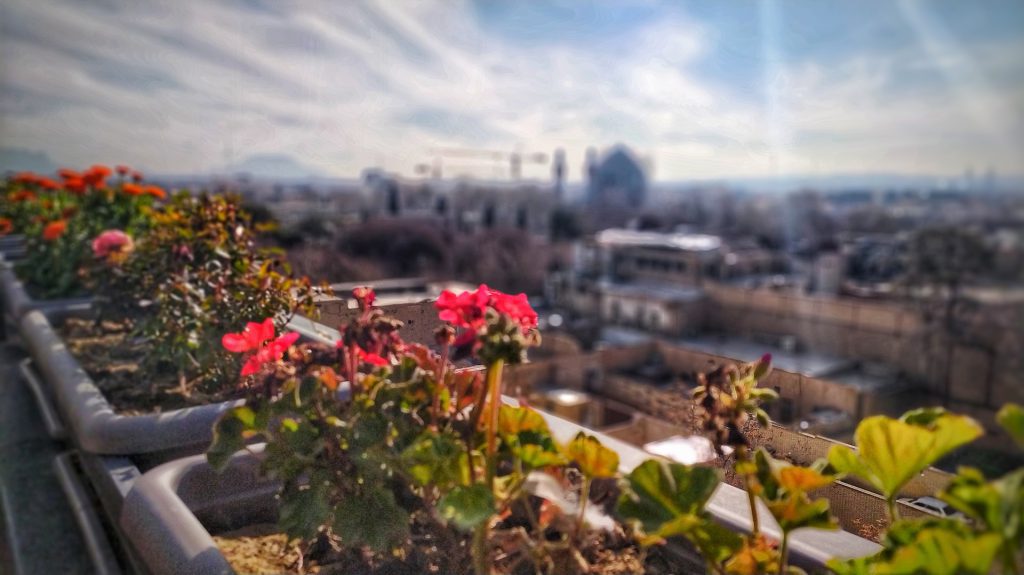
The ideal time to explore Isfahan is in spring. During this season, the nights are warm, and the daytime temperatures are pleasant. It’s a great time to enjoy the cities without extreme heat or discomfort.
Spring brings a burst of colors and a pleasant atmosphere to Isfahan. You can comfortably explore the attractions during the day and experience the vibrant culture. The evenings are mild and perfect for strolling, trying local food, and immersing yourself in the city’s charm.
From mid-June onward, the weather becomes hot, making visits less enjoyable. To ensure a pleasant trip, plan your visit in spring to make the most of it.
Public Transportation in Isfahan: From Airport to Downtown
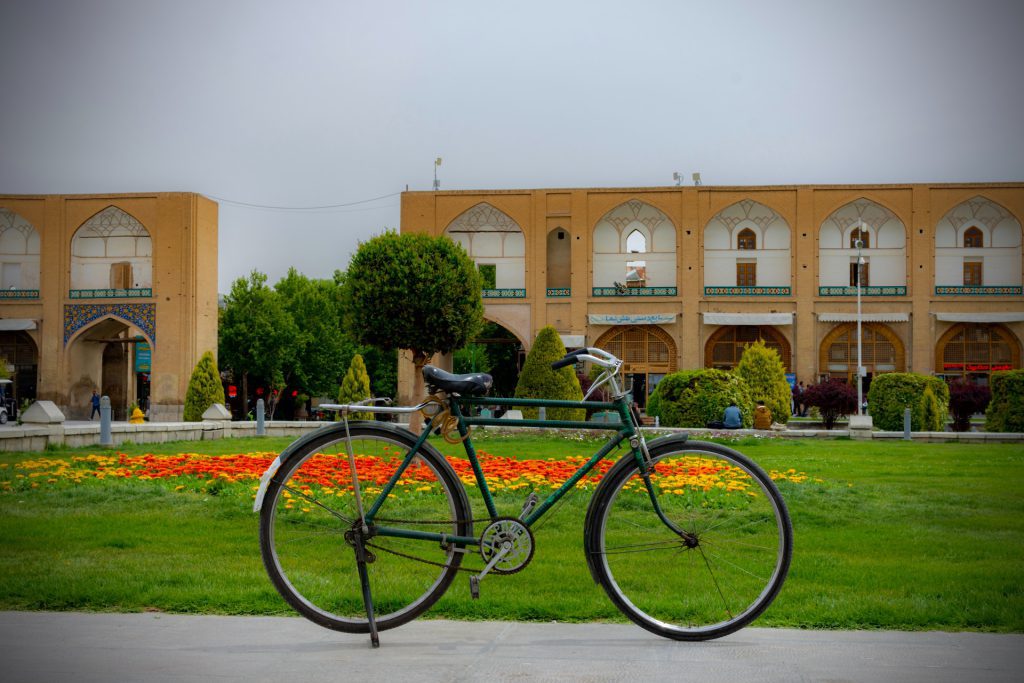
In Isfahan city, you can use the metro, taxis, and buses for public transportation and easily access different parts of the city and its tourist attractions.
If you have a private car, you may encounter odd and even travel plans that restrict access to tourist attractions and shopping centers. It’s better to use the public transportation network, which offers a wide variety of options.
Metro
The city has a recently established subway system. Currently, Line 1 runs from north to south, connecting various areas of the city. You can use this line to reach some attractions located near the metro stations.
Bus
Buses are a popular and extensive mode of transportation. The city has 176 bus lines and over 1,600 buses, making it one of the best bus systems in the country. Linear buses and Bus Rapid Transit (BRT) lines are available, providing convenient access to different parts of the city.
Cycling
Cycling is a popular way to explore the city. You can rent bicycles from stations located throughout the city by providing the necessary documents and renting them for a specified period.
Isfahan Best Foods
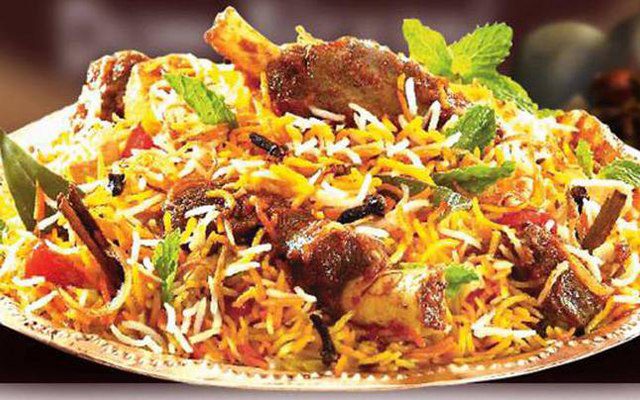
Isfahan is renowned for its rich culinary heritage, offering a delightful array of traditional dishes. Here are some of the best traditional dishes, along with recommended authentic restaurants known for their expertise in preparing these delicacies:
Beryani
Beryani is a savory rice dish that is a specialty of Persia Isfahan. It is typically made with saffron-infused rice, tender pieces of meat (such as lamb or chicken), and a blend of aromatic spices. One highly recommended restaurant to savor this dish is “Shahrzad Restaurant,” known for its flavorful Beryani.
Bastani Sonnati
Bastani Sonnati is a traditional Iranian ice cream that is rich, creamy, and infused with flavors like saffron, rosewater, and pistachios. For the best Bastani Sonnati, head to “Gelato Mio,” a popular ice cream parlor known for its authentic and high-quality Persian ice creams.
Ash Reshteh
Ash Reshteh is a hearty Persian noodle soup made with a variety of herbs, legumes, and reshteh (thin noodles). It is a cherished comfort food. For a delicious bowl of Ash Reshteh, visit “Moslem Restaurant,” a well-known eatery that specializes in traditional Iranian soups and stews.
These recommendations are based on the expertise and recommendations of industry professionals who have a deep understanding of the culinary scene. By visiting these authentic restaurants, you can indulge in the best traditional dishes that the city has to offer and experience the authentic flavors of the region.
Isfahan Restaurants
Isfahan has great restaurants with delicious food. Whether you want traditional Persian dishes or vegetarian options, these restaurants offer a memorable dining experience.
Shahrzad Restaurant
Shahrzad restaurant is very old and has traditional decorations. They serve traditional food and have friendly staff. The prices are high, but the experience is worth it.
Zima Healthy Food
Zima is a restaurant on Bozorgmehr Street that serves vegetarian food in Iran. Most of the mentioned restaurants are vegan-friendly too.
Pasto
Pasto is a nice cafe-restaurant located at the end of Madi Niasarm. It has great food and a welcoming atmosphere. You can go there after visiting the Si-o-se-pol Bridge.
Keryas Luxurious Restaurant
Keryas is a fancy restaurant on top of Arg-e Jahan Nama. The staff is friendly, the food is delicious, and the prices are high.
Bam-e Shahr
Bam-e Shahr is a restaurant at the end of Hezar Jerib street. They have a wide menu, and the prices are high. It’s best to visit at night to enjoy the city lights.
Isfahan Hotels
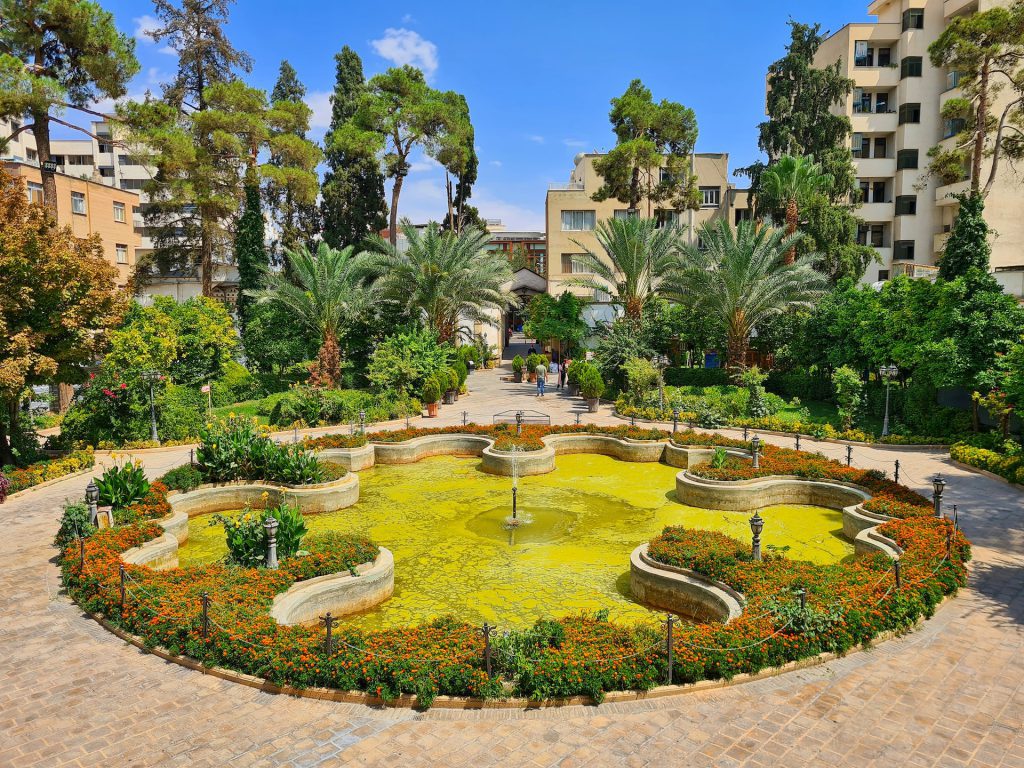
When planning a trip to this unforgettable city, it’s important to choose the right place to stay. Here are some great hotels in Isfahan:
Ghasr Monshi Boutique Hotel
This hotel is in an old building from the Qajar dynasty. It has a Persian atmosphere and is a national heritage site. The hotel has a nice courtyard and serves delicious Persian food. The rooms are clean and spacious. It is 20 meters away from Hasan Abad Bazaar.
Bekhradi Historical House
This hotel is in a 400-year-old building. It is comfortable and beautiful, like a museum. It’s located near a historical site from the Safavid era. It is also near attractions like Naghsh-e Jahan Square and Chehel Sotoun Palace.
Keryas Traditional Hotel
This hotel is a short walk from Naghsh-e Jahan Square. It’s in an old building from the Qajar era and has 15 rooms. The hotel offers modern facilities and a peaceful atmosphere. It is close to attractions like the Abbasi Great Mosque and Mashrouteh House of Isfahan.
Abbasi Hotel
This 5-star hotel has a beautiful design from the Safavid era. It has about 225 rooms and a lovely garden. The hotel is located on Chahar Bagh Boulevard, near attractions like Naqshe Jahan Square or Menar Jonban.
Khajoo Hotel
This 4-star hotel offers the amenities of a 5-star hotel. It has clean rooms and friendly staff. The hotel is in Khajoo Boulevard near Khaju Bridge.
Consider your preferences and needs when choosing a hotel in Persia Isfahan. Whether you want historical charm, comfort, or modern amenities, there are options available to suit your preferences.
Things to Know Before Visiting Isfahan
Isfahan, a city rich in history and architectural wonders, is a popular destination for travelers visiting Iran. Before embarking on your journey to this enchanting city, there are a few key things to keep in mind to ensure a smooth and enjoyable experience.
Financial Transactions
Because of sanctions, Iran is not connected to the international money transfer system. In Isfahan, you won’t find ATMs that accept foreign bank cards. So, it’s important to bring enough cash in euros or dollars for your expenses.
Safety
Isfahan, like the rest of Iran, is considered a safe place for tourists. It has low crime rates, and many people visit every year. However, it’s still wise to be cautious and take necessary safety precautions while traveling here to ensure a safe and enjoyable experience.
FAQs about Isfahan
Q1: What is Isfahan Iran known for?
A1: A lot of people think Isfahan is the prettiest city in Iran and one of the prettiest in the world. It has lots of roads with trees and gardens full of flowers, and there are also many lovely parks along the Zayandeh Rood river. Isfahan also has old markets, bridges, palaces, mosques, and tall towers called minarets that are 1300 years old.
Q2: What is Isfahan in Islam?
A2: Isfahan, an important city located in central Iran, served as the magnificent capital for both the Seljuq and Safavid dynasties. Their enduring legacies solidified Iran (previously known as Persia) as the cultural center of the eastern Islamic world, particularly in terms of language (Persian), art, and architecture.
Q3: Why is Isfahan called half of the world?
A3: Isfahan is considered one of the prominent cities in Iran when it comes to historical landmarks and tourist attractions. The locals refer to this city as the “half of the world” because they believe it encapsulates the wonders and beauties of an entire world within itself.
Q4: What are the famous facts about Isfahan?
A4: Isfahan is the third-largest city in Iran and the third most populous, following Tehran and Mashhad. It boasts six UNESCO-registered heritage sites. The city is often referred to as “Nesf-e Jahan,” which translates to “half of the world,” due to its magnificent Islamic architecture, picturesque boulevards, ancient bridges, palaces, and mosques.
Q5: Is Isfahan a good place to live?
A5: Isfahan provides a relaxed lifestyle combined with the convenience of urban living, thanks to its excellent facilities, riverbank, and friendly residents. It is an ideal city for international students, offering a pleasant and welcoming atmosphere that draws thousands of people for leisure, education, and business purposes.
Q6: Why visit Isfahan?
A6: Isfahan is recognized as a significant archaeological hub, comparable to world-class destinations. Many of its artifacts have been registered as monuments, highlighting the city’s rich historical and cultural heritage. It holds a prominent global position in various fields, including art, economy, science, industry, commerce, and tourism, making it highly regarded on an international scale.
Q7: Is Isfahan beautiful?
A7: In 1979, Isfahan’s Maydan-e Emam, also known as “Imam’s Square” in Persian, was recognized as a UNESCO World Heritage site. Presently, the city still bears much of its former splendor. Numerous visitors consider here to be the most exquisite city in Iran and among the most stunning worldwide.
Q8: What language is Isfahan?
A8: The majority of the population in Isfahan speaks Persian as their first language. However, there is also a minority of residents who speak other languages such as Luri, Turkic, Georgian, Biyabanaki, and Armenian.
Q9: How old is Isfahan Iran?
A9: Isfahan has a rich history that traces back to ancient times. During the Achaemenid Empire (648–330 BCE), it was known for its diversity and religious tolerance, with a mix of different ethnic and religious communities living harmoniously. At its peak, it was one of the largest cities in the world, rivaling renowned cities like Athens and Rome, and surpassing the grandeur of cities like London, Paris, and Istanbul.
Q10: What is the nickname of Isfahan?
A10: Isfahan is famously known as “Nesf-e Jahan” or “Half of the World,” a nickname that reflects its historical importance as a thriving hub of commerce, culture, and art. This title highlights the city’s significant contributions and its reputation as a central and influential place in these domains.
Last words: Experience the Best of Isfahan with a Customized Tour
Isfahan is an important city in Iran. It’s at a crossroads of major routes and used to be the capital during the 16th and 17th centuries. Isfahan is known for its beautiful buildings, bridges, and mosques with colorful tiles. It has many historical places and is called “Nesf-e-Jahaan,” meaning half of the world because of its wonders and beauty.
If you are seeking an extraordinary travel experience in Iran and have set your sights on exploring the enchanting city of Isfahan, embarking on a customized and tailored tour is highly recommended. At ToIranTour, we understand that every traveler has distinctive preferences and expectations when exploring a new destination.
Our Iran tours to Isfahan encompass a wide range of attractions and activities designed to showcase the city’s grandeur and charm. Moreover, ToIranTour goes beyond conventional tourist sites, introducing travelers to the local way of life and off-the-beaten-path experiences. Contact us now to embark on a tailor-made journey!

